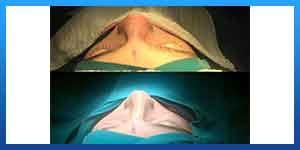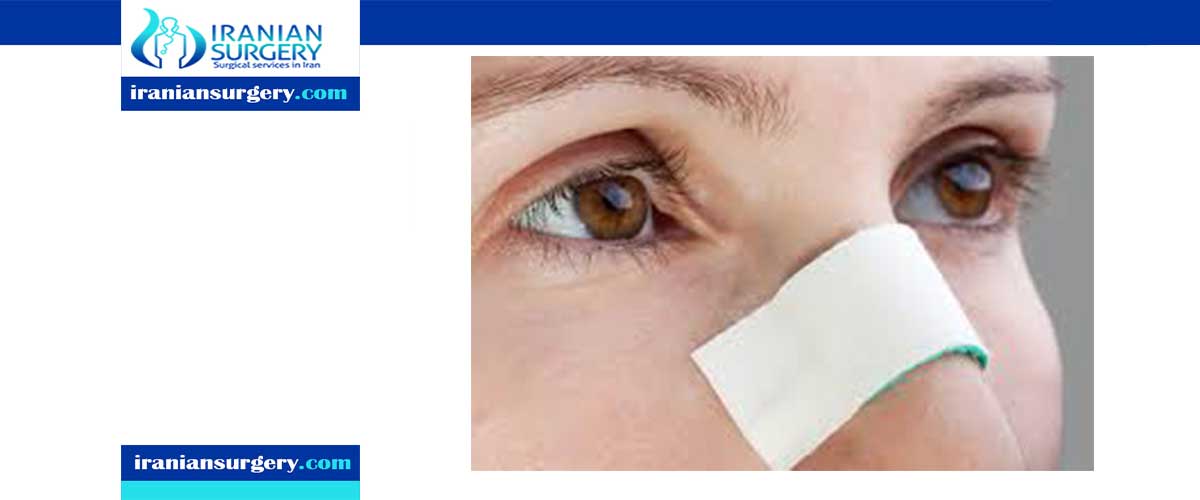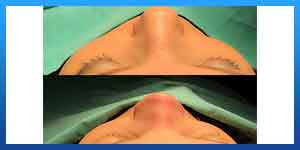Author : Dr. Maryam Mosleh / Otolaryngologist, Head and Neck Surgeon.
Can septoplasty and rhinoplasty be done together?
How long does it take to recover from rhinoplasty and septoplasty?
What is the Difference between Rhinoplasty and Septoplasty?
Rhinoplasty and septoplasty are both plastic surgery procedures involving the nose. Rhinoplasty prioritizes the outside, or aesthetic appearance of the nose, while septoplasty deals with structural issues inside the nose, such as issues with breathing. Often, the two types of surgeries are combined and completed together to optimize both the form and function of the nose for the future.
One of the biggest differences between rhinoplasty and septoplasty is why the surgeries are performed. The goal of a septoplasty is to correct a deviated septum, or a septum that is leaning too far to one side or the other, blocking a person’s airway and causing congestion while Rhinoplasty can be performed to make a nose larger or smaller, to make it less crooked, or to smooth out a hump in the nose. It can also be performed to restore a nose to its original state after a person has a bad injury or has broken the nose.
Finally, there are cases when rhinoplasty surgery is performed to improve the way a person’s nose work. Even if a person doesn’t have a deviated septum, the shape of the nose or the size of certain aspects of it can create breathing problems.
Read more about : Septoplasty Recovery Time
Read more about : Rhinoplasty healing stage
Read more about : Pros and cons of deviated septum surgery
Read more about : Open rhinoplasty Vs closed Rhinoplasty by Dr.Maryam Mosleh
Comparison between Rhinoplasty and Septoplasty
General Information
General Information about Rhinoplasty |
|
Cost | $ 800 - 2500 |
Anesthesia | General |
Hospital Stay | 1 Day |
Back to Work | 1 to 2 Weeks |
Duration of Operation | 2-4 Hours |
Minimum Stay in Iran | 1 Week |
General Information about Septoplasty |
|
Cost | $ 1000 - 2000 |
Anesthesia | General/Local |
Hospital Stay | the same day |
Back to Work | 1 Week |
Duration of Operation | 1-2 Hours |
Minimum Stay in Iran | 1 Week |
What is Rhinoplasty?
Rhinoplasty (RIE-no-plas-tee) is surgery that changes the shape of the nose. The motivation for rhinoplasty may be to change the appearance of the nose, improve breathing or both. In Other words, Rhinoplasty can change the size, shape or proportions of your nose. It may be done to repair deformities from an injury, correct a birth defect or improve some breathing difficulties.
Why it's done
Rhinoplasty can help address:
. Enlarged, bulbous, drooping, upturned or hooked nasal tip
. Large, wide or upturned nostrils
. Nasal asymmetry
. Removing a hump on the nose
. Straightening the bridge
. Reshaping the nose's tip
. A broken nose
. Correcting the nose after an injury
. Opening breathing passages
. Making the nose bigger or smaller

What is Septoplasty?
Septoplasty is a surgical procedure to straighten the bone and cartilage dividing the space between your two nostrils (septum). When the septum is crooked, it's known as a deviated septum. A deviated septum can make it harder to breathe through your nose and can increase the risk of sinus infections due to poor drainage. In other words, Septoplasty is a surgical procedure to correct a deviated septum and targets functional concerns within the nose. Septoplasty straightens the septum, allowing for better airflow through your nose.
Read more about : Rhinoplasty in Iran
Read more about : Septoplasty in Iran
Read more about : Bulbous nose surgery
Read more about : Revision rhinoplasty
Why it's done
. Septoplasty straightens the nasal septum by trimming, repositioning and replacing cartilage, bone or both.
. perform to improve breathing (Improve airflow through the nose) or help with other symptoms
. Control nosebleeds
. Enhance visualization of the inside of the nose (to identify other nasal problems)
. Relieve nasal or sinus headaches associated with swelling of the inside of the nose.
. Promote drainage of the sinus cavities
Rhinoplasty Procedure
Rhinoplasty surgery may be done inside your nose or through a small external cut (incision) at the base of your nose, between your nostrils. Your surgeon will likely adjust the bone and cartilage underneath your skin. Your rhinoplasty surgeon can change the shape of your nasal bones or cartilage in several ways, depending on how much needs to be removed or added, your nose's structure, and available materials. For small changes, the surgeon may use cartilage taken from deeper inside your nose or from your ear. For larger changes, the surgeon can use cartilage from your rib, implants or bone from other parts of your body.
After these changes are made, the rhinoplasty surgeon places the nose's skin and tissue back and stitches the incisions in your nose.
Septoplasty Procedure
During a septoplasty, the surgeon will attempt to straighten bent cartilage and bone in the septum. Firstly, they lift the mucosa lining covering the cartilage and bone.
The surgeon then reshapes the cartilage and bone, sometimes removing portions. After that, they will then put the lining back in place.
If enlarged turbinates are causing a blockage, the surgeon might attempt to shrink them with radiofrequency reduction. In some other cases, the surgeon will remove a portion of the turbinate.
Finally, the incision is closed with absorbable suture. Soft silicone splints may be inserted inside each nostril to support the septum.
Both procedures can usually be performed as day surgeries under general anesthesia.
Who is a Good Candidate?
Good Candidate for Rhinoplasty
Rhinoplasty surgery is popular with both men and women, although more women choose to have nose surgery. The best candidates should meet these general qualifications:
. Good physical health with no serious medical conditions or illnesses
. Non-smoker
. Complete facial growth
. Positive outlook on life
. Patients who have realistic aesthetic goals and expectations
. They have a deformity which needs correcting.
. They have reached the right age, which means that younger people should wait until they reach physical maturity and then undergo this procedure. Females usually attain physical maturity earlier at the age 16 onwards while male teenagers have to wait until the age of 18 onwards. The reason for this is that the nose stops growing and changing significantly at this age.
Good Candidate for Septoplasty
A septoplasty procedure can help you breathe more easily. Commonly done for individuals dealing with a deviated septum, there are other medical issues with the nose that can cause breathing problems. A septoplasty procedure is typically performed for individuals who have the following:
. Deviated septum or crooked nasal septum.
. Nasal valve insufficiency so the nose doesn't properly open and close when breathing.
. Consistent snoring or sleep apnea symptoms at night.
. Chronic or consistent nosebleeds.
. Nasal polyps or growths which can impede proper breathing.
. Oversized turbinates which are the inner structures that help keep the nose moist when breathing.
Comparing the Risks and Side effects
Rhinoplasty Risks and Side effects
Rhinoplasty surgery risks include:
. Anesthesia risks
. Infection
. Poor wound healing or scarring
. Change in skin sensation (numbness or pain)
. Nasal septal perforation (a hole in the nasal septum) is rare. Additional surgical treatment may be necessary to repair the septum but it may be impossible to correct this complication.
. Difficulty breathing
. Unsatisfactory nasal appearance
. Skin discoloration and swelling
. Possibility of revision surgery
Read more about : Rhinoplasty age
Read more about : Rhinoplasty complication
Read more about : Rhinoplasty scar
Septoplasty Risks and Side effects
As with any major surgery, septoplasty carries risks, such as bleeding, infection and an adverse reaction to the anesthetic. Other possible risks specific to septoplasty include:
. Continued symptoms, such as nasal obstruction
. Excessive bleeding
. A change in the shape of your nose
. A hole in the septum
. Sense of smell
. Clotted blood in the nasal space that has to be drained
. Temporary numbness in the upper gum, teeth or nose
How long does each procedure take?
Rhinoplasty
Most people only need to do one Rhinoplasty procedure to see results. Surgery takes two to four hours, depending on the type of nose surgery: Complicated procedures take longer time.
Septoplasty
Operations are completed within 1 to 2 hours depending on the type of septoplasty: Complicated procedures take longer time.
How long is the Recovery period?
Rhinoplasty Recovery Time
Approximate recovery after rhinoplasty is as follows:
. Day 1 Return home. Use cool compresses for 24 hours. Some swelling and bruising, mild discomfort. Change mustache dressing as needed (often 10 to 20 times).
. Day 2-3 maximum bruising and swelling.
. Days 5-14 External stitches removed or dissolving. Internal and external nasal dressings removed by Doctor. Bruising going away.
. Week 2-4 much of swelling has begun to go away. Breathing better.
. 1 Year Enjoy your final result
Septoplasty Recovery Time
Recovery after septoplasty alone is as follows:
. Day 1 Return home. Nasal congestion mild. Change mustache dressing as needed (often 10 to 20 times).
. Day 2-5 Nasal stuffiness is main problem.
. Day 5-7 internal nasal splints removed by Doctor. Stuffiness and nasal congestion much better.
. Day 7-10 slightly worse nasal congestion.
. Week 3-4 Nasal breathing much improved.
Comparing cost
Rhinoplasty cost
The cost of Rhinoplasty varies depending on the surgeon’s skill, the type of Rhinoplasty (Open or closed) and geographical location. The average cost for a Rhinoplasty procedure is between $ 800 - 2500.
Septoplasty cost
The average cost of Septoplasty in Iran is between $ 1000 – 2000.
Read more about All you need to know about rhinoplasty in Iran
Read more about Rhinoplasty in Iran
Read more about Sign of infection after rhinoplasty
Read more about Septoplasty with Turbinate Reduction
Read more about Liposuction in Iran



